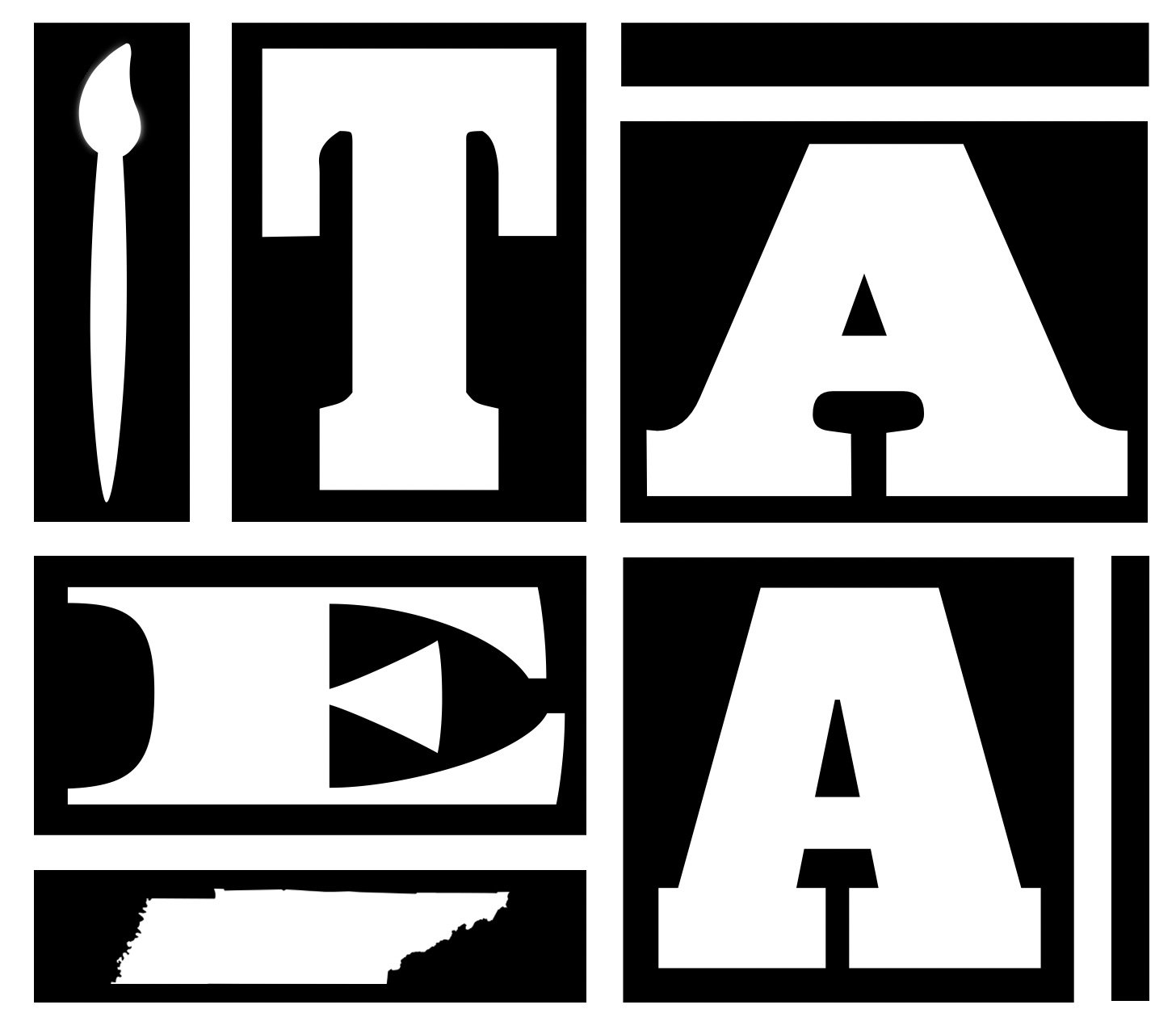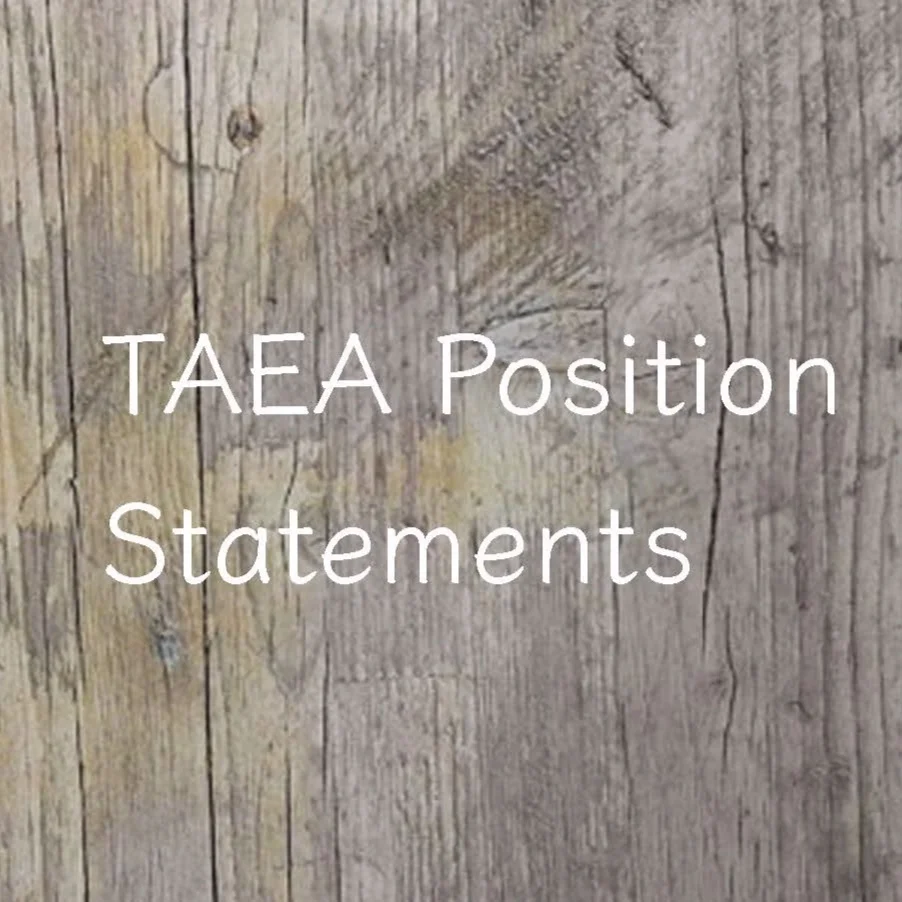TAEA Position Statement on Certified/Licensed Visual Arts Educators in Pre K through 12 School Settings
[Adopted November 2018]
The visual arts in Pre K through 12 school settings should be taught by certified/licensed and highly qualified visual arts educators. A certified/licensed and highly qualified arts educator should have pre service experience in the grade level and content area in which they are pursuing the profession. Certified/Licensed and highly qualified visual visual arts educators should:
• Have a thorough understanding of the visual arts including history, studio skills, art criticism, aesthetics, and the study of visual art and cultures.
• Have a knowledge of teaching methodologies and how to apply them to the visual arts classroom.
• Have an ongoing understanding of and ability to integrate current and emerging technology into their teaching.
• Understand students as learners, including diverse characteristics, abilities, and learning styles.
• Help students understand the ways in which the arts make meaning, connect with the entire curriculum, and prepare students for success in school, work, and life.
• Pursue ongoing professional development to support their continuous improvement in both teaching and the arts.
TAEA Position Statement on Elementary Level Art
Class Scheduling
[Adopted November 2018]
All students have a minimum of one 45-50 minute art class per week throughout the school year.
The Association recognizes ratios of personnel to students differ from district to district. For education (teaching and learning experiences) to take place, it is recommended that at the elementary level personnel for visual art education classes should meet the following guidelines:
Student class size of, at most, 20-25 students.
At the elementary level, the number of certified art specialists is sufficient to provide art experiences for a total of at least 45 minutes per week per class, throughout the school year.
At the elementary level, the teacher/pupil ratio in regularly scheduled art experiences is no greater than 1:400-500 students per school.
All students have a minimum of one art class per week.
Visual arts educators teach no more than six classes per day and have planning time equal to that of other educators. A minimum of 5 minutes should be scheduled between classes to allow for clean-up and preparation for succeeding classes.
TAEA Position Statement on Middle Level Art Class Scheduling
[Adopted November 2018]
For continuity and sequencing of student learning, instruction in the visual arts is required or at least advised at each grade level.
At the middle school level, the visual art education staff is sufficiently equipped and trained to provide advanced experiences in art at the level of Pre-Advanced Placement courses.
The Association recognizes ratios of personnel to students differ from district to district. For education (teaching and learning experiences) to take place, it is recommended that at the middle school level personnel for visual art education courses should meet the following guidelines:
Student class size of, at most, 25-30 students.
At the middle school level, visual art educators teach no more than six classes per day (i.e., art courses may meet daily or biweekly and may meet for multiple class periods per day; they can also meet by semester or by grading period) and have planning time equal to that of other educators. A minimum of 5 minutes should be scheduled between classes to allow for clean-up and preparation for succeeding classes.
At the middle school level, the teacher/pupil ratio is no greater than 1:180 students per day.
All students have at least 9 weeks of visual art instruction at each grade level.
TAEA Position Statement on High School Level Art Class Scheduling
[Adopted November 2018]
In many states and school districts, all students are required to take one course in the arts (including fine and performing arts) in order to meet the high school graduation requirements. To meet this requirement, at minimum, the number of students per course should not exceed 25. Students interested in pursuing higher education in the visual arts often take multiple courses in the visual arts. Schools offering curriculum in a variety of media also need personnel capable of meeting the needs of students as well as the needs of the curriculum.
At the high school level, the visual art education staff is sufficiently equipped and trained to provide advanced experiences in art at the level of Advanced Placement or international Baccalaureate courses.
The Association recognizes ratios of personnel to students differ from district to district. For education (teaching and learning experiences) to take place, it is recommended that at the high school level personnel for visual art education courses should meet the following guidelines:
1. Student course size of, at the most, 25 students.
2. At the high school level, visual art educators teach no more than six classes per day (i.e., art course may meet daily or biweekly and may meet for multiple class periods per day; they can also meet by semester or by grading period) and have planning time equal to that of other educators.
3. Educator to student maximum ratio of 1:180 per day.
4. All students are required to take one course in the arts in order to meet the high school graduation requirements (varies per state).
5. Schools offering curriculum in a variety of media also need personnel capable of meeting both the needs of students as well as the need of the curriculum.
TAEA Position Statement on Importance of Visual Arts Supervisors/ Administrators in PreK-12 Education
[Adopted October 2019]
TAEA believes that school districts should support visual arts education programs by having and maintaining one or more visual arts education supervisor positions. Visual Arts Supervisors/Administrators ensure exemplary visual arts programs that meet the needs of all learners through the implementation of K-12 programs with:
• rigorous curriculum aligned to state visual arts standards
• engaging instruction
• meaningful learner assessment
• highlighting students’ artworks for stakeholders
• quality equipment, facilities, instructional materials, and other resources
• appropriate and equitable allocation of budgets
• community advocacy and partnerships
• participation in interviewing and recommending visual arts educators for hire
• observations of visual arts educators with content specific feedback
• relevant professional development for visual art educators
• collaboration with school and district administration on policies impacting visual arts teachers and students
• communication with the Fine Arts Director at the Tennessee Department of Education
• development of teacher leaders
TAEA recognizes that while the visual arts shares characteristics with other arts disciplines (i.e. music, theatre, and dance), it stands as its own unique discipline within the arts. TAEA believes it is imperative that supervisors/administrators with experience in the field of visual arts education provide support for visual arts educators, as well as, implementation, maintenance, and growth of district programs.
TAEA Position Statement on Professional Development
[Adopted October 2019]
TAEA asserts that meaningful, rigorous professional development targeted toward the visual arts and visual arts education is essential to the lifelong learning of art educators. TAEA believes that all art educators should have access to ongoing professional development appropriate to their roles.
TAEA supports opportunities for building enriched relationships between theory and practice. Examples of professional development opportunities include: studio practices; engagement with contemporary and traditional art forms; visual art pedagogy, curriculum design, and instructional methods; leadership development; emerging and ever-changing technologies and their relationship to art and education; and theories related to lifelong learning, cognition, and human development.
TAEA recognizes that these opportunities can take place in a variety of contexts and supports peer to peer learning among professionals. TAEA believes that optimal professional development can take place through self-study and self-initiated outreach, participatory learning communities, mentoring relationships, formal presentations, and events.
TAEA believes that dynamic professional development takes place when visual arts educators and organizations partner toward shared professional goals. These opportunities can take place among colleagues, as well as with universities, museums, galleries, cultural organizations, community groups, government agencies, and philanthropic organizations; between TAEA divisions; as well as with non-visual arts professionals. Meaningful professional development can also take place between the visual arts and other artistic disciplines, as well as between the visual arts and other subject areas.
TAEA promotes professional development and learning through local, state, and national conferences, web-based platforms, institutes, in-services, workshops, and retreats that share a variety of perspectives.

